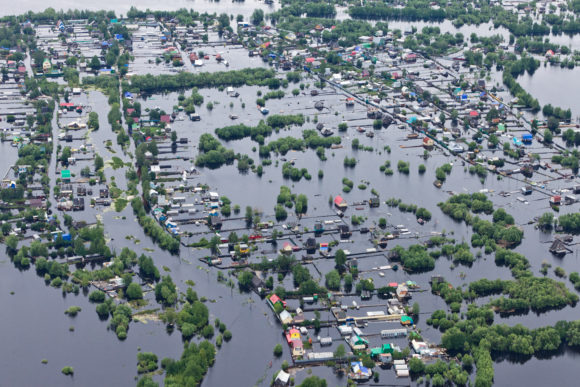Not Only in FEMA Zones, Not Only During Hurricane Season
Major companies across the U.S. are increasingly recognizing the risk for inland flooding and with good reason.
As recent hurricanes like Harvey and Florence made clear, water can cause as much or even more damage and can result in greater costs than wind.
According to catastrophe modeling firm RMS, about 90% of Harvey’s insured losses resulted from inland flooding. Strikingly, flooding is impacting more and more businesses outside of FEMA’s designated critical flood zones.
According to the New York Times, new data from the First Street Foundation flood model — Flood Factor — has affirmed what insureds and insurers have been witnessing firsthand during catastrophic inland flooding events — that is, that many properties are at greater risk for flood across the United States than traditional government estimates and maps show.
Specifically, the First Street Foundation model estimates that 14.6 million properties are at risk from a 100-year flood, a shocking increase from the 8.7 million properties flagged on FEMA flood maps.
What’s behind this major expansion in flood exposure and losses?
First, building codes have not kept pace with the perils that come with escalated flood risks, and development has continued to expand in places and in ways that leave properties vulnerable to water and flooding.
Second, flooding is increasing and broadening its reach due to an increased frequency of extreme weather events, including intense rainfall coupled with rising sea-levels.
Third, FEMA flood maps, while updated, can be out of date and are not designed to account for flooding caused by excessive rainfall.
According to First Street Foundation’s model, Chicago, Los Angeles, New York City, Cape Coral, Fla., and Philadelphia, Pa., are among the cities sitting on the greatest increase in flood risk.
Time to Reassess & Prioritize Flood Exposure
Risk managers with locations not traditionally considered to be flood-exposed need to take a closer look at flood risk and which properties need to be hardened against the exposure – not just during hurricane season, but all year round.
Flood Emergency Response: Not just for FEMA Flood Zones
Every company, regardless of locale, should consider developing a Flood Emergency Response Plan (FERP) – both as part of hurricane preparation and as part of overall emergency response planning.
A well thought-out FERP is critical to help companies keep employees safe and ensure that a company is prepared to protect property in the event of a flood. For example, a plan may establish procedures to keep water away from electrical equipment and articulate how and where to store important documents and protect fire protection equipment; it should establish shutdown procedures for equipment and utilities, and for a complete facility shutdown when needed. The plan should also include pre-vetted resources that can be marshaled quickly in the event of flooding – from backup and contingency systems to vendors to salvage damaged equipment.
Loss Prevention & Mitigation Measures: Well Before a Storm
While companies are reviewing and fine-tuning hurricane preparation plans, they should also focus on flood — even if they are not in a traditionally flood-prone zone. Planning should encompass loss prevention measures that should be put in place now and when a storm is imminent, including such standard, but pivotal, practices as:
- Securing rack structures and shelving to prevent toppling.
- Removing valuable documents or equipment from the premises or relocating them to upper floors.
- Creating a barrier against incoming water using materials such as sandbags, flood doors, flood shields or even inflatable barriers when a storm is approaching.
- Shielding valuable equipment — that which cannot be moved away from doors and windows or removed to an offsite location — with water-resistant tarps when a storm is approaching.
In addition, companies should work with their brokers to assess the possibility of purchasing flood insurance in places where they have not previously.
Learning from The Past, Looking to the Future
Insurers stand ready to partner with insureds to help them assess and mitigate escalating inland flood exposure, and to prioritize loss mitigation measures based on the newest flood information and their insured values. Along with loss prevention expertise before a loss (and after, to expedite recovery), insurers can also provide valuable insights into the latest modeling that can help risk managers better understand inland flood risk for the continental U.S. and the possible effects of climate change on flood risk from storm surge and extreme precipitation.
It is a new world in many ways, and prudent risk management during this hurricane season means a new focus on inland flood risk. Together, insureds and insurers can look back to consider the lessons learned from storms like Harvey and Florence and look ahead using the latest data and modeling to understand, prioritize and effectively harden facilities against the rising reality of inland flood exposure.
Topics Trends Catastrophe USA Flood Hurricane
Was this article valuable?
Here are more articles you may enjoy.



 Chubb Wins Latest Battle With New York Diocese in Bid to Avoid Sex Abuse Claims
Chubb Wins Latest Battle With New York Diocese in Bid to Avoid Sex Abuse Claims  AIG General Insurance Chairman McElroy to Retire May 1
AIG General Insurance Chairman McElroy to Retire May 1  GM Ends OnStar Driver Safety Program After Privacy Complaints
GM Ends OnStar Driver Safety Program After Privacy Complaints  California Sees Two More Property Insurers Withdraw From Market
California Sees Two More Property Insurers Withdraw From Market 



